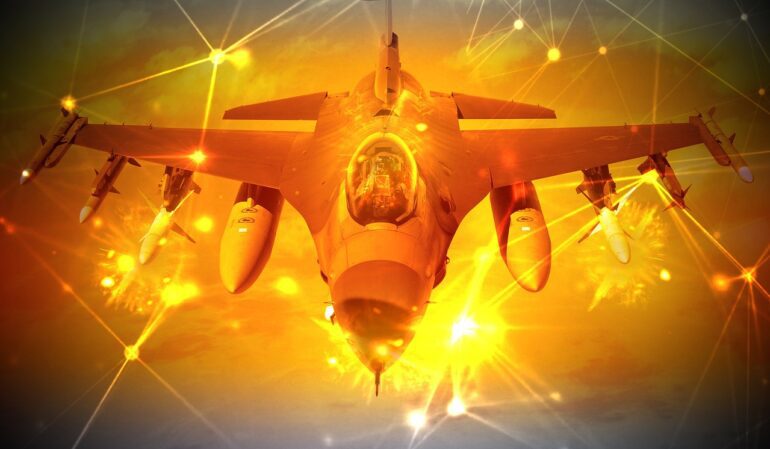- Recent flight tests conducted by DARPA and the Air Force demonstrate the safe and effective use of an autonomous fighter jet equipped with AI.
- These tests included “nose-to-nose” dogfights between an autonomous aircraft and a manned F-16, marking a significant milestone in AI-driven aviation.
- The project, known as the Air Combat Evolution program, showcased the capability of machine learning agents to control flight paths and engage in dynamic combat maneuvers.
- Over 100,000 lines of flight-critical software changes were implemented to enhance the AI-driven tools’ performance.
- Collaboration with various organizations, including Lockheed Martin and MIT, supported the program’s development and testing phases.
- Secretary of the Air Force Frank Kendall highlighted the transformational nature of this capability, signaling a shift towards greater integration of AI in military aviation.
Main AI News:
Cutting-edge advancements in artificial intelligence (AI) have been showcased in recent flight tests overseen by the Defense Advanced Research Projects Agency (DARPA) and the Air Force. These tests have demonstrated the safe and efficient utilization of an autonomous fighter jet equipped with AI, including engaging in “nose-to-nose” dogfights against a human F-16 pilot, according to authoritative sources.
During DARPA’s AlphaDogFight Trials a few years back, algorithms demonstrated their dominance in computer-simulated battles against military aviators. Subsequently, the agency’s Air Combat Evolution program has utilized a modified F-16, known as the X-62A VISTA (Variable In-flight Simulator Test Aircraft), to rigorously assess machine learning agents in the airspace above Edwards Air Force Base, California.
A comprehensive series of 21 test flights took place for the project between December 2022 and September 2023, as detailed in an update from the Department of Defense on the ACE program released recently.
Colonel James Valpiana, the commandant of the Air Force Test Pilot School, remarked in a video accompanying the update, “Beginning in December of 2022, that was the first application of machine learning agents to control the flight path of fighter aircraft.” Significant enhancements, totaling more than 100,000 lines of flight-critical software changes, were implemented over time to refine the capabilities of these AI-driven tools.
In September, a significant milestone was achieved as the X-62 engaged in aerial combat against a manned F-16. Lieutenant Colonel Maryann Karlen, the deputy commandant of the test pilot school, highlighted, “We built up in safety using the maneuvers — first defensive, then offensive, then high aspect nose-to-nose engagements where we got as close as 2,000 feet at 1,200 miles per hour.“
The exercise marked a historic event: “the first AI vs human within-visual-range engagement (a.k.a. ‘dogfight’), conducted with actual manned F-16 aircraft,” as emphasized in the DOD program update.
While details on the outcome of this encounter were not disclosed at the time of publication, defense officials underscored the significance of these initiatives in showcasing the viability of AI technologies in navigating complex combat scenarios such as close-in and air-to-air engagements.
“In advance of formal verification methods for AI-based autonomy, the team pioneered new methods to train and test AI agent compliance with safety requirements,” stated the DOD program update. It further emphasized the adherence to ethical standards, including combat training rules and clear avenues of fire, while deploying AI-based systems.
Secretary of the Air Force Frank Kendall lauded the achievements, affirming that the capability demonstrated is “transformational.” Notably, human pilots were present onboard the autonomous aircraft during test flights, ready to intervene if necessary. However, during the dogfights over Edwards Air Force Base, such intervention was not required.
Several organizations collaborated in supporting the program, including Calspan, Cubic Corporation, EpiSci, Lockheed Martin Skunk Works, physicsAI, Shield AI, the University of Iowa Operator Performance Laboratory, Johns Hopkins Applied Physics Laboratory, the MIT Computer Science and Artificial Intelligence Laboratory, and the MIT Lincoln Laboratory.
Looking ahead, Kendall expressed his commitment to further exploring AI’s potential in military aviation, disclosing his intention to fly aboard an F-16 in autonomous flight mode later this year. The successes of the ACE program have played a pivotal role in shaping future endeavors, including the Air Force’s collaborative combat aircraft (CCA) program aimed at developing next-generation autonomous drones for counter-air operations and beyond. This initiative is poised to receive substantial investment in the coming years.
During a panel discussion at the Reagan National Defense Forum, Kendall emphasized the critical role of AI on the battlefield, stressing its ability to execute complex tasks with unparalleled speed and accuracy. He underscored the pivotal difference in response times between human pilots and AI-driven systems, highlighting the inevitability of AI’s dominance in such scenarios.
Conclusion:
The successful real-world testing of autonomous fighter jets equipped with AI marks a significant advancement in military aviation technology. This demonstration underscores the potential for AI to revolutionize air combat dynamics, driving demand for further development and integration of AI technologies in defense systems. Companies specializing in AI-driven defense technologies stand to benefit from increased market demand for such innovations.

